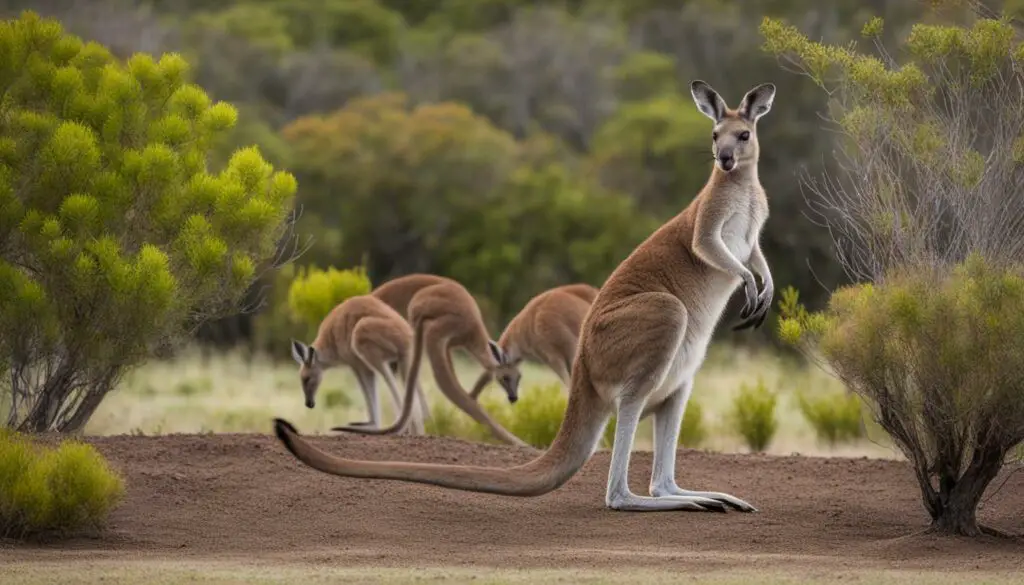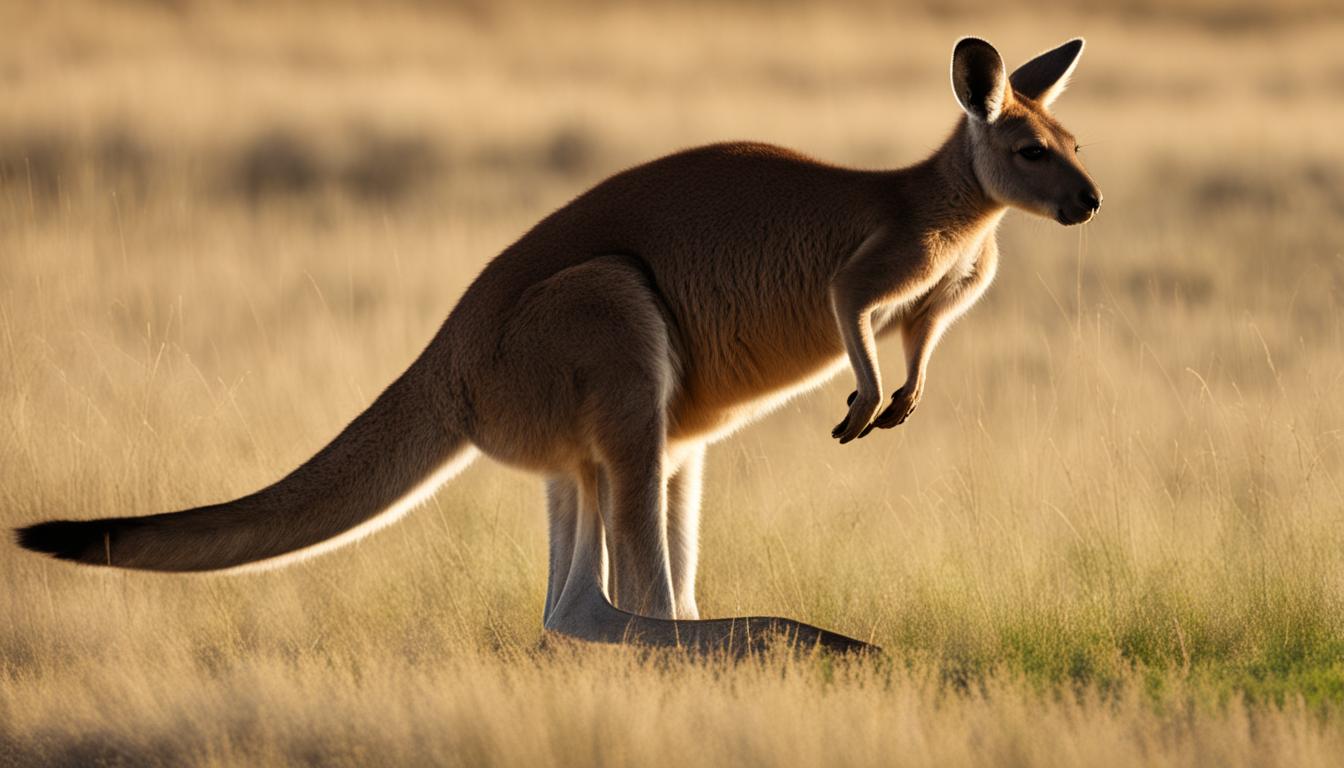Have you ever wondered how kangaroos behave in the wild and in captivity? Kangaroo behavior encompasses a wide range of fascinating traits, from their social interactions to their feeding patterns, mating rituals, communication methods, and even their aggressive tendencies. In this article, we will delve into the intriguing world of kangaroo behavior and shed light on their unique adaptations to their environment.
But before we embark on this exciting journey, let’s explore some crucial keywords related to kangaroo behavior: kangaroo behavior, kangaroo social behavior, kangaroo feeding behavior, kangaroo mating behavior, kangaroo communication, and kangaroo aggression.
Are you ready to discover the secrets behind how these remarkable creatures behave in different scenarios? Join us as we uncover the mysteries of kangaroo behavior and gain a deeper understanding of their incredible adaptations and interactions with their surroundings. Let’s dive in!
Kangaroo Social Behavior and Communication
Kangaroos are fascinating creatures that exhibit unique social behavior and communication patterns within their groups. They live in loose group structures called mobs, which can vary in composition over time. The core of a kangaroo group consists of adult females with their young and juveniles, with a few adult males also present. However, associations among mature males are loose and not long-lasting. This flexible social structure allows kangaroos to adapt to changing circumstances and dynamics within their environment.
Within a kangaroo mob, social interactions occur through various non-aggressive behaviors. One common behavior is touch, where kangaroos engage in gentle nose touching, lip licking, and nuzzling. These actions serve as important forms of communication and bonding among individuals within the group. Social play is also commonly observed, particularly between young males and between mothers and their offspring. This playful behavior helps young kangaroos develop important social and motor skills.
Communication among kangaroos involves a combination of visual and tactile signals. For example, kangaroos use their large eyes and erect ears to visually communicate their intentions and emotions to other group members. They also employ a range of body postures and facial expressions to convey messages. Additionally, kangaroos use scent marking to communicate their presence and territory boundaries to other kangaroos. This involves rubbing their body against trees or the ground to leave behind their scent, which other kangaroos can detect.
Kangaroo Social Behavior and Communication Table
| Types of Behavior | Description |
|---|---|
| Touch | Gentle nose touching, lip licking, and nuzzling among individuals |
| Social Play | Playful interactions between young males and between mothers and their offspring |
| Visual Communication | Use of large eyes, erect ears, body postures, and facial expressions to convey messages |
| Tactile Communication | Scent marking through rubbing against trees or the ground to communicate presence and territory boundaries |
Kangaroo social behavior and communication play vital roles in maintaining the cohesion and coordination within a mob. These behaviors enable kangaroos to establish and reinforce social bonds, share information, and navigate their dynamic social dynamics. Understanding these intricate social interactions provides valuable insights into the fascinating world of kangaroos and their remarkable adaptations to their environment.
Kangaroo Feeding Behavior and Foraging Patterns
In this section, we will explore the fascinating feeding behavior and foraging patterns of kangaroos. As herbivores, kangaroos rely on consuming grasses and other vegetation to meet their nutritional needs. Their feeding habits and specialized digestive system enable them to efficiently extract nutrients from even low-quality forage.
Kangaroos have a unique method of eating, using their strong jaws to rip vegetation and their mobile lips to move it into their mouths. This allows them to graze for long periods, maximizing their nutrient intake. Their specialized digestive system further aids in this process, as it allows them to ferment plant material in their stomachs, breaking it down more effectively.
These crepuscular feeders are most active during dawn and dusk, when food is more easily available. This behavior aligns with their natural instinct to optimize feeding opportunities. During these times, kangaroos can be observed grazing and foraging in their natural habitats.
| Eating Behavior | Foraging Patterns |
|---|---|
| Ripping vegetation with strong jaws | Most active during dawn and dusk |
| Using mobile lips to move vegetation into mouth | Efficiently extracting nutrients from low-quality forage |
| Fermenting plant material in stomachs | Maximizing nutrient intake |
Overall, the feeding behavior and foraging patterns of kangaroos showcase their remarkable adaptations to survive on a herbivorous diet. By understanding these behaviors, we gain valuable insights into the ecological role and unique capabilities of these iconic Australian marsupials.

Kangaroo Mating Behavior and Reproduction
Kangaroos have unique mating behavior and reproduction strategies that contribute to their survival and species’ growth. During the mating season, male kangaroos engage in fierce competition for access to females. This competition involves biting, kicking, and boxing, with the largest and strongest male, known as the “old man” or “boomer,” dominating the group.
Female kangaroos have the ability to control their reproduction and choose their mates. After mating, the female kangaroo gives birth to a tiny, underdeveloped joey that crawls into her pouch to continue its development. The mother kangaroo provides milk and keeps the joey in her pouch until it is fully developed. This unique form of parenting involves the mother’s close care and protection of her young.
“The mating season is a crucial time for male kangaroos to prove their dominance and reproductive fitness. It is a violent and intense period of fighting and aggression,” explains Dr. Jane Simmons, a wildlife biologist specializing in kangaroo behavior. “The mother kangaroo’s pouch provides a safe and nurturing environment for the joey, allowing it to grow and develop before venturing out into the world.”
The intricate mating behavior and parenting strategies of kangaroos contribute to the survival and success of their species. By understanding these behaviors, scientists and wildlife conservationists can develop effective strategies to protect and conserve kangaroo populations.
| Behavior | Mating Season | Parenting |
|---|---|---|
| Males compete for access to females | Yes | No |
| Females control reproduction | Yes | No |
| Birth of underdeveloped joey | No | Yes |
Kangaroo Aggression and Territorial Behavior
Kangaroos are known for their aggressive behavior when they feel threatened or during the mating season. They have a range of tactics at their disposal to defend themselves, including biting, kicking, and boxing. Their most powerful weapon is their clawed hind feet, which they can use to inflict serious injury. Kangaroos have been known to disembowel dogs and even humans in self-defense.
During the breeding season, male kangaroos display territorial behavior as they fight to maintain access to females. They mark their territories through scent marking and visual displays such as standing upright and showing their size and strength. This serves as a warning to other males to stay away.
In addition to physical aggression, kangaroos may also make use of their environment to assert dominance or evade predators. They are known to seek refuge in water when threatened, as they are excellent swimmers. This behavior allows them to protect themselves and assert their dominance in their natural habitat.
Kangaroo Aggression and Territorial Behavior
“Kangaroos have a unique way of fighting using their powerful hind legs, and they can cause serious damage to any opponent.”
Understanding kangaroo aggression and territorial behavior is key to appreciating their unique adaptations and survival strategies. While they can appear docile when observed from a distance, it is important to respect their boundaries and give them the space they need to thrive in their natural habitat.
Conclusion
Kangaroos are fascinating creatures with a wide range of behaviors that are influenced by their natural environment and social dynamics. Understanding kangaroo behavior provides valuable insights into their unique adaptations and interactions with their surroundings.
These marsupials have irregular activity rhythms, being most active at night and during periods of low light. However, they can also be seen in bright sunlight, hopping effortlessly across the Australian landscape. Kangaroos are not truly social animals, but they form loose group structures called mobs, consisting of adult females, their young, and juveniles. Within these groups, non-aggressive behaviors such as touch, grooming, and social play are observed, strengthening social bonds.
Feeding behavior and foraging patterns are essential for kangaroos’ survival. They are herbivores that have adapted to efficiently extract nutrients from low-quality forage. Kangaroos have unique eating techniques, using their strong jaws to rip vegetation and their mobile lips to move it into their mouths. They are crepuscular feeders, meaning they are most active during dawn and dusk when food is readily available.
During the mating season, kangaroos exhibit dominant and aggressive behaviors. Male kangaroos compete fiercely, biting, kicking, and boxing to establish their dominance and gain access to females. Females, on the other hand, have control over their reproduction and choose their mates. The process of kangaroo parenting involves the mother’s close care and protection of her young, providing milk and shelter in her pouch until the joey is fully developed.
In addition to aggression during mating, kangaroos can display defensive territorial behavior when they feel threatened. They use various tactics, including biting, kicking, and boxing, and their powerful hind feet can inflict serious injuries. Water can also play a role in their defense mechanisms, as they may use it to evade predators or assert their dominance over their territory.
In conclusion, kangaroo behavior encompasses a wide range of locomotion patterns, social behaviors, feeding habits, and reproductive strategies. These remarkable animals have adapted to thrive in their unique environment, and by understanding their behavior, we can gain a deeper appreciation for their incredible adaptations and their role within the Australian ecosystem.
How Does Boxing Behavior Fit Into the Overall Behavior of Kangaroos?
The kangaroo boxing behavior serves a significant purpose in the overall behavior of kangaroos. It is primarily used for establishing dominance within the group and competing for mating opportunities. Kangaroos will stand on their hind legs and engage in boxing matches, using their powerful front paws to strike their opponents.
FAQ
Do kangaroos live in groups?
Yes, kangaroos live in loose group structures called mobs.
Are kangaroos social animals?
While kangaroos travel and feed in groups, they are not truly social as individual members move freely.
How do kangaroos communicate?
Kangaroos communicate through various non-aggressive behaviors such as nose touching, lip licking, and nuzzling.
What do kangaroos eat?
Kangaroos are herbivores and feed on grasses and other vegetation.
When are kangaroos most active?
Kangaroos are crepuscular feeders, meaning they are most active during dawn and dusk when food is more easily available.
How do kangaroos reproduce?
Female kangaroos give birth to tiny, underdeveloped joeys that crawl into their pouches for further development.
Can kangaroos be aggressive?
Yes, kangaroos can display aggressive behavior when they feel threatened or during the mating season.
How do kangaroos defend themselves?
Kangaroos use tactics such as biting, kicking, and boxing to defend themselves. They also have clawed hind feet that can cause serious injury.
Do kangaroos exhibit territorial behavior?
Kangaroos may exhibit territorial behavior, especially during the breeding season when males protect their access to females.











